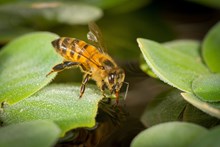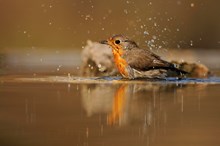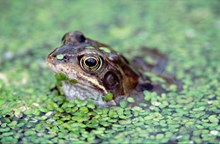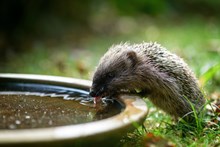05 July, 2021
Nature agency calls on Scots to put water out for wildlife this summer
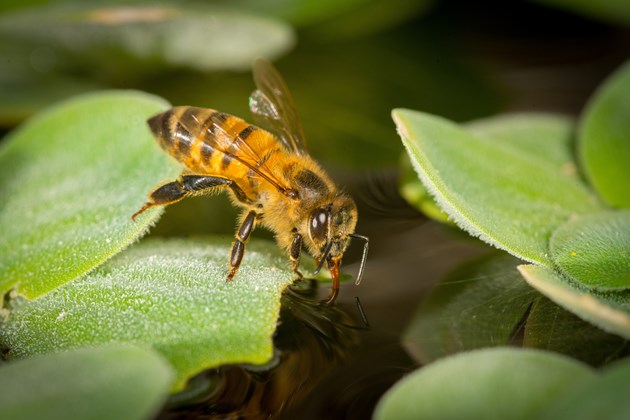
NatureScot, Scotland’s nature agency, is urging everyone to take simple steps – such as putting out water for wildlife this summer – to help local wildlife, reverse nature loss and help fight climate change.
Looking after nature is good for people, the planet and wildlife, and adding water to any outdoor space is just one of the many things we can all do to help these creatures and reverse the trends.
NatureScot Chief Executive Francesca Osowska said:
“Nature loss and climate change are inextricably linked. Scotland has already lost nearly 25% of its wildlife, with birds, butterflies, mammals and moths showing an overall decline of 31% since 1994. But there is hope if everyone takes action now. If each and every one of us commits this summer to do something for nature – be that providing a pond, nature volunteering, planting pollinator-friendly flowers, mowing less or leaving areas in our gardens to flourish – we have the collective power to help reverse this trend.”
Water is essential for wildlife. A pond provides drinking and bathing water for mammals and birds. Amphibians such as frogs, toads and newts use it as shelter and for breeding. Honeybees use water to control the temperature in hives and also for drinking, whilst dragonflies, pond skaters and damselflies breed in water.
Francesca added:
“Ponds attract a vast array of wildlife, and help sustainably manage water in intense rainfall. If you don’t have access to a garden, even using a washing up bowl of water or saucer of water on a windowsill can help, adding twigs or pebbles for insects to rest above the water. Doing small things really can make a big difference.”
NatureScot’s research during the pandemic found 50% of people wanted to do more to help local wildlife. Additionally Scottish Government research found almost 80% said climate change is an ‘immediate and urgent problem’, with over a quarter (26%) more concerned about tackling climate change since the pandemic began.
Summer is a great season to make such changes, so NatureScot has launched its summer Make Space For Nature campaign outlining 14 easy ways to take small but important steps to help our wildlife thrive.
- Go natural
For gardens with paved areas, or artificial grass, add flowering pots or window boxes to encourage pollinators and other beasties to take refuge, and act as stepping stones for wildlife around urban areas. We can help alleviate local flooding by reducing the amount of paving in our gardens.
- Mow less
And make a butterfly border. Reduce mowing to create an undisturbed wildflower patch, strip or meadow, and encourage the local council to do the same at suitable green spaces. These create natural corridors for wildlife to move through towns and cities, and will continue to be important as our climate changes.
- Love weeds
Weeds may traditionally have a bad name, but many, such as dandelions provide food for all types of pollinators such as bees, butterflies, moths, hoverflies and beetles. Think of them as amazingly resilient wildflowers - rather than weeds. Get out a magnifying glass or take a close up photo to see how beautiful they are.
- Start small
Many plants do well in containers such as window boxes, pots and hanging baskets. Herbs such as lavender, rosemary, sage and thyme are popular with pollinators, and brighten life up.
- Hedge not fence
Hedgerows offer a habitat that fences can't match. Plant flowering trees and shrubs such as hazel, willow, blackthorn and hawthorn - these also allow wildlife to move through gardens.
- Share cuttings
Plants and seeds can be expensive, but for many pollinator-friendly species, existing plants can be divided or new plants can be grown from cuttings and shared with friends and neighbours.
- Be a lazy gardener
Allow vegetation to dieback naturally - leave twigs, leaves and natural debris as shelter for insects and other wildlife. Leave seedheads - a food source for birds and homes for insects.
- Help local birds
Add a bird box and feeders to a garden or outdoor space. Feeders that attach to windows are available, and are a great way to observe local birds, particularly if people are housebound or without a garden. Chicks need protein to grow quickly so having more flowers to attract insects really helps, and adding meal worms to bird feeders provides a snack for hungry chicks.
- Feed the soil
Sixty-three percent of the total carbon locked in our soil is found in our peatlands - help conserve them by using only peat-free garden products. Use local farmyard manures and home-made composts. Avoid pesticides – great alternatives are available. Take a closer look, observe the wee beasties helping recycle our waste, control pests, and keep the nutrient cycle running.
- Litter pick or beach clean
When outdoors take a bag and pair of gloves and where safe to do so, dispose of litter along the way. Whether in our oceans, parks, rivers, or woods, it's dangerous to wildlife - animals get trapped or try to eat it. Much of our waste doesn’t biodegrade so will stay in our natural environment for years. Get neighbours, friends and family involved and clean up the area.
- Provide water
Ponds attract wildlife such as frogs, bees, newts, and birds, and also help sustainably manage water in intense rainfall. A pond doesn’t have to be a big outlay, even using a washing-up bowl of water or saucer of water on a windowsill can help. Add twigs or stones for somewhere insects can rest above water.
- Explore underwater
With 41% of Scotland’s population living within 5km of the coast, there’s likely a great rock pooling site nearby. Walk or cycle a net and buckets to the water’s edge and see what’s hiding between the rocks. Remember to return any wildlife back to the water.
- Be a citizen scientist
Get involved in this fun way to help wildlife. Submit sightings of birds, frogs, butterflies and more to let us know where wildlife is (and isn’t) and contribute to biodiversity and climate change research. Find something suitable in our list of projects.
- Volunteer near and far
This can be a fun way to make a difference, meet new friends and get outdoors. Find out more about our volunteering opportunities, or search on the Volunteer Scotland website. Take inspiration from projects helping communities manage their local green spaces and start a local one.
For more ways to help nature this summer go to Make Space For Nature this summer.
Contact information
- Name
- NatureScot Media
- Telephone
- 0131 316 2655
- media@nature.scot
Notes to editors
Further information
The State of Nature Scotland Report 2019 highlights changes in biodiversity and the drivers of these changes. NatureScot is one of the State of Nature 2019 partners.
This marine and terrestrial biodiversity in Scotland publication, highlights biodiversity changes and helps measure progress towards national biodiversity commitments.
NatureScot’s lockdown survey, undertaken in two waves, provides an insight into people’s outdoor visit behaviour and engagement with nature during lockdown.
Scottish Government climate change research explores the general public’s attitude to climate change and to the green recovery after the COVID-19 pandemic.
NatureScot is Scotland's nature agency. We work to enhance our natural environment in Scotland and inspire everyone to care more about it. Our priority is a nature-rich future for Scotland and an effective response to the climate emergency. For more information, visit our website at www.nature.scot or follow us on X at https://x.com/NatureScot
’S e NatureScot buidheann nàdair na h-Alba. Bidh sinn a’ neartachadh àrainneachd na h-Alba agus a’ brosnachadh dhaoine gu barrachd suim a chur ann an nàdar. Tha e mar phrìomhachas againn gum bi nàdar na h-Alba beairteach agus gun dèilig sinn gu h-èifeachdach le èiginn na gnàth-shìde. Tha an tuilleadh fiosrachaidh aig www.nature.scot no air X aig https://x.com/NatureScot

